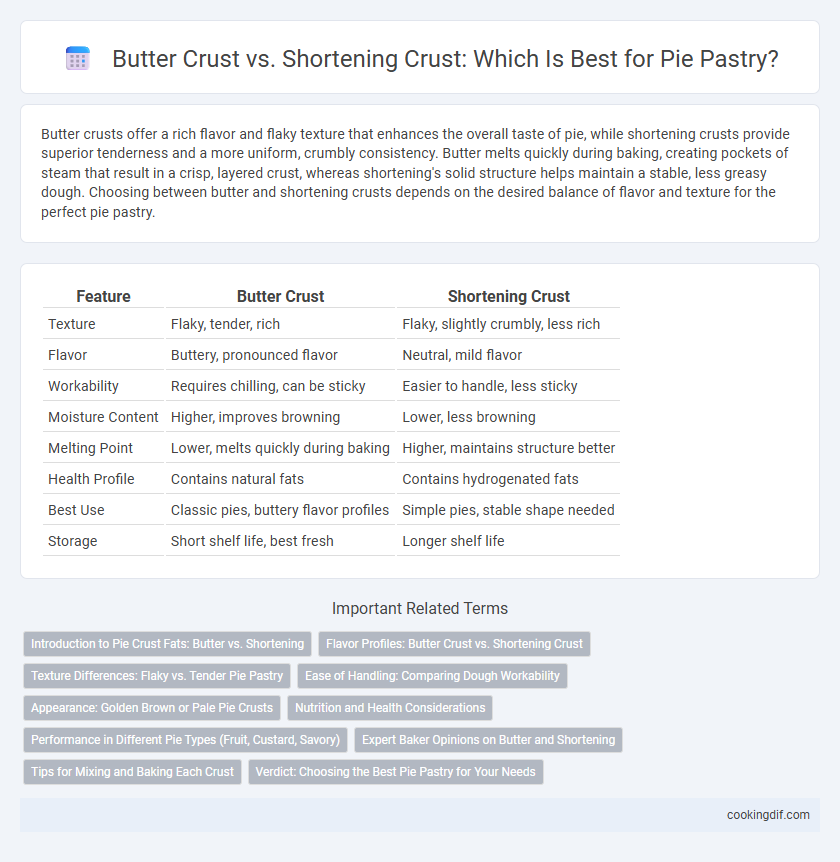Butter crusts offer a rich flavor and flaky texture that enhances the overall taste of pie, while shortening crusts provide superior tenderness and a more uniform, crumbly consistency. Butter melts quickly during baking, creating pockets of steam that result in a crisp, layered crust, whereas shortening's solid structure helps maintain a stable, less greasy dough. Choosing between butter and shortening crusts depends on the desired balance of flavor and texture for the perfect pie pastry.
Table of Comparison
| Feature | Butter Crust | Shortening Crust |
|---|---|---|
| Texture | Flaky, tender, rich | Flaky, slightly crumbly, less rich |
| Flavor | Buttery, pronounced flavor | Neutral, mild flavor |
| Workability | Requires chilling, can be sticky | Easier to handle, less sticky |
| Moisture Content | Higher, improves browning | Lower, less browning |
| Melting Point | Lower, melts quickly during baking | Higher, maintains structure better |
| Health Profile | Contains natural fats | Contains hydrogenated fats |
| Best Use | Classic pies, buttery flavor profiles | Simple pies, stable shape needed |
| Storage | Short shelf life, best fresh | Longer shelf life |
Introduction to Pie Crust Fats: Butter vs. Shortening
Butter crusts offer rich flavor and a crisp, flaky texture due to their water content and melting properties, essential for classic pie pastry. Shortening crusts provide a tender, crumbly texture with higher fat content and no water, resulting in less shrinkage and easier handling. Understanding the distinct fat compositions helps bakers choose between the buttery taste and precise texture control for perfect pie crusts.
Flavor Profiles: Butter Crust vs. Shortening Crust
Butter crust offers a rich, creamy flavor with a slightly nutty undertone, enhancing the overall taste of sweet and savory pies. Shortening crust provides a more neutral taste, allowing the filling's flavors to stand out without interference. The choice between butter and shortening significantly influences the pie's flavor profile and texture experience.
Texture Differences: Flaky vs. Tender Pie Pastry
Butter crust produces a flaky pie pastry due to its higher water content, which creates steam and distinct layers during baking. Shortening crust results in a tender and crumbly texture, as the fat coating the flour inhibits gluten formation more effectively. The choice between butter and shortening significantly influences the mouthfeel and structural integrity of pie crusts.
Ease of Handling: Comparing Dough Workability
Butter crust dough offers superior workability due to its higher moisture content, creating a pliable and easy-to-roll texture ideal for delicate pie pastries. Shortening crusts, containing solid fats with lower water content, produce a stiffer dough that may require more effort to knead and shape but results in a flakier final product. The choice between butter and shortening influences dough elasticity and handling ease, impacting the overall pie-making experience.
Appearance: Golden Brown or Pale Pie Crusts
Butter crusts produce pies with a rich, golden brown color due to the milk solids caramelizing during baking, creating an appealing and appetizing surface. Shortening crusts often result in a paler pie crust because shortening lacks milk solids, leading to less browning and a more uniform, matte finish. The choice between butter and shortening impacts not only flavor but also the visual presentation, with butter crusts typically favored for their warm, inviting appearance.
Nutrition and Health Considerations
Butter crusts for pie pastry provide essential fat-soluble vitamins like A and D while containing saturated fats and cholesterol that may impact heart health if consumed in excess. Shortening crusts are typically free of trans fats when made from non-hydrogenated shortenings and have a neutral flavor, offering a more shelf-stable option with less cholesterol but higher in processed fats. Choosing between butter and shortening crust depends on dietary goals, balancing natural nutrients against the type of fats and their effects on cardiovascular health.
Performance in Different Pie Types (Fruit, Custard, Savory)
Butter crust offers a rich flavor and flakier texture, performing exceptionally well with fruit pies by enhancing their natural sweetness and providing a tender, crisp base. Shortening crusts excel in custard pies due to their neutral taste and higher melting point, which creates a sturdier, less greasy shell that holds creamy fillings without sogginess. For savory pies, the choice depends on desired texture: butter crusts add richness and a crumbly bite, while shortening crusts deliver a firmer, more uniform bite that supports hearty fillings.
Expert Baker Opinions on Butter and Shortening
Expert bakers favor butter crust for its superior flavor and flaky texture, praising its rich, creamy taste that enhances pie fillings. Shortening crusts are valued for their ease of handling and ability to produce tender, consistently flaky layers without melting quickly. Many professionals recommend a blend of butter and shortening to balance flavor depth with optimal dough workability.
Tips for Mixing and Baking Each Crust
For a butter crust, keep ingredients cold and handle the dough minimally to ensure flakiness, chilling it before rolling out and baking at a high temperature (around 425degF/220degC) to achieve a golden, crisp texture. When working with a shortening crust, use a pastry blender to cut the fat into the flour until pea-sized crumbs form, which creates a tender, crumbly pastry that benefits from a slightly lower baking temperature (375degF/190degC) to prevent over-browning. Both crusts require blind baking with pie weights or dried beans to avoid shrinkage and ensure an evenly baked bottom.
Verdict: Choosing the Best Pie Pastry for Your Needs
Butter crust provides a rich flavor and flaky texture due to its high water content, making it ideal for pies where taste and tenderness are prioritized. Shortening crust offers superior flakiness and a more stable structure, perfect for pies that require sturdy pastry able to hold heavy fillings without shrinking. Selecting between butter and shortening crust depends on your emphasis on flavor richness versus structural integrity for the specific pie type.
Butter crust vs shortening crust for pie pastry Infographic

 cookingdif.com
cookingdif.com